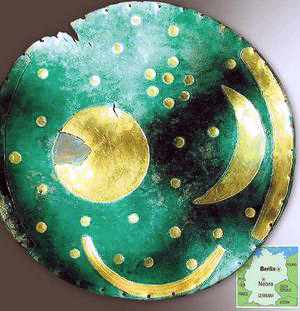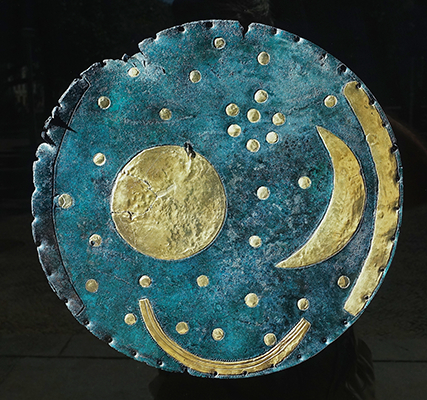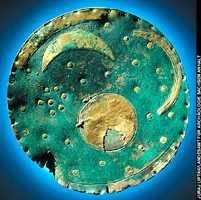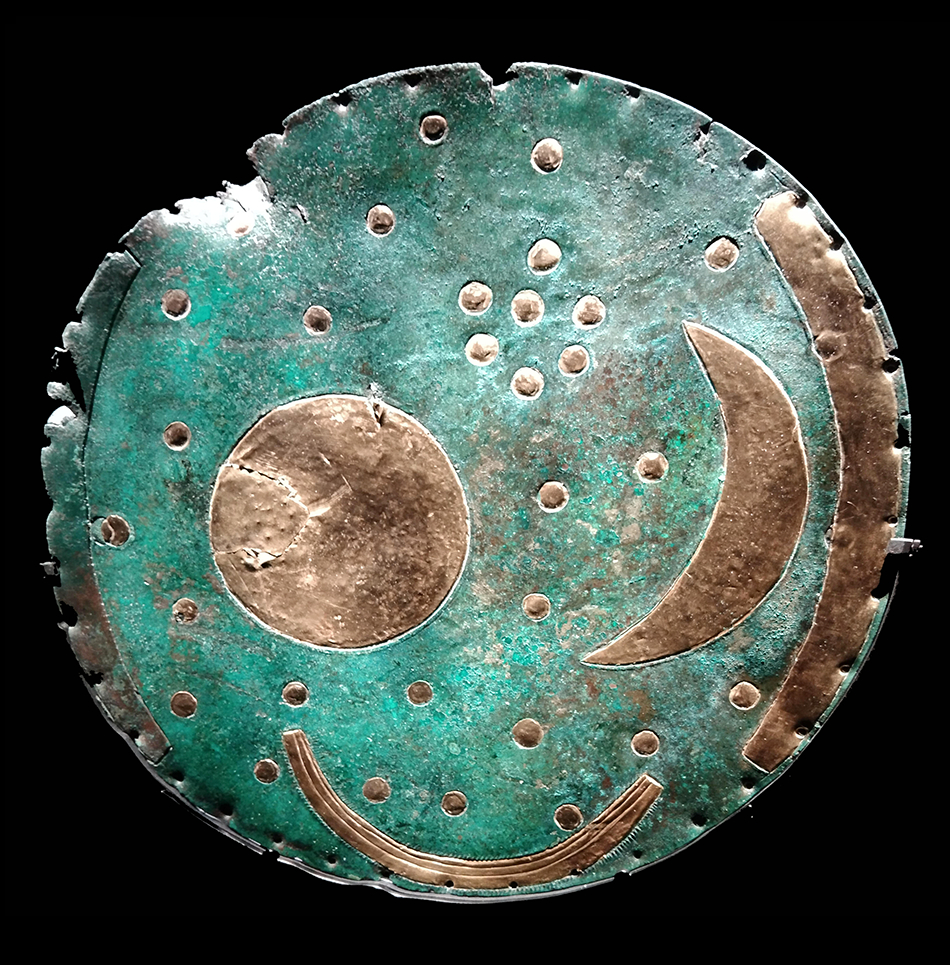Back to Don's Maps
Bronze Age Sky Disc Deciphered
A group of German scientists has deciphered the
meaning of one of the most spectacular archeological
discoveries in recent years: The mystery-shrouded sky
disc of Nebra was used as an advanced astronomical
clock.
The purpose of the 3,600 year-old sky disc of Nebra, which
caused a world-wide sensation when it was brought to the
attention of the German public in 2002, is no longer a matter of
speculation.
A group of German scholars who studied this archaeological
gem has discovered evidence which suggests that the disc was
used as a complex astronomical clock for the harmonization of
solar and lunar calendars.
"This is a clear expansion of what we knew about the meaning
and function of the sky disc," said archeologist Harald Meller.
Photo: Courtesy Michael Hess
Text: Deutsche Welle, http://www.dw-world.de/dw/article/0,2144,1915398,00.html
A thirteenth month?
Unlike the solar calendar, which indicates the position of the earth as it revolves around the sun, the lunar calendar is based on the phases of the moon. A lunar year is eleven days shorter than the solar year because 12 synodic months, or 12 returns of the moon to the new phase, take only 354 days.The sky disc of Nebra was used to determine if and when a thirteenth month -- the so-called intercalary month -- should be added to a lunar year to keep the lunar calendar in sync with the seasons.
"The functioning of this clock was probably known to a very small group of people," Meller said.
Bronze Age science
 Artist's view of the 3600-year-old bronze disc inlaid with a gold-leaf sun, moon and stars.
Artist's view of the 3600-year-old bronze disc inlaid with a gold-leaf sun, moon and stars.
This Photo: The Age newspaper at
http://www.theage.com.au/news/world/sky-disc-revelation-shines-light-on-bronze-age/2006/02/28/1141095740221.html
The 32-centimeter-wide (seven-inch) bronze disc with gold-leaf
appliqués representing the sun, the moon, and the stars is the
oldest visual representation of the cosmos known to date. A
cluster of seven dots has previously been interpreted as the
Pleiades constellation as it appeared 3,600 years ago.
The explanation of the disc's purpose sheds new light on the
astronomical knowledge and abilities of the Bronze Age people,
who used a combination of solar and lunar calendars as
important indicators for agricultural seasons and passage of
time.
"The sensation lies in the fact that the Bronze Age people
managed to harmonize the solar and lunar years. We never
thought they would have managed that," Meller said.

The sky disc of Nebra.
Rephotography: Don Hitchcock 2018
Source: Poster on the entrance door to the Museum of Halle
 The sky disc of Nebra was found near Europe's oldest observatory in Goseck
The sky disc of Nebra was found near Europe's oldest observatory in Goseck
According to astronomer Wolfhard Schlosser of the Rurh
University at Bochum, the Bronze Age sky gazers already knew
what the Babylonians would describe only a thousand years
later.
"Whether this was a local discovery, or whether the knowledge
came from afar, is still not clear," Schlosser said.
Ever since the disc was discovered, archaeologists and
astronomers have been puzzled by the shape of the moon as it
appears on the disc.
"I wanted to explain the thickness of the crescent on the sky
disc of Nebra because it is not a new moon phase," said
Hamburg astronomer Ralph Hansen.
In his quest to explain why the Nebra astronomers created a
sky map with a four or five days old moon on it, Hansen
consulted the "Mul-Apin" collection of Babylonian documents
from the 7th and 6th centuries B.C.
These cuneiform writings represent, according to Hansen, a compendium of "astronomic knowledge from the earliest times." They also contain a calculation rule for the crescent that looks strikingly similar to the one from Nebra.
According to the ancient Babylonian rule, a thirteenth month should only be added to the lunar calendar only when one sees the constellation of the moon and the Pleiades exactly as they appear on the Nebra sky disc.
 The Bronze Age astronomers would hold the Nebra clock
against the sky and observe the position of the celestial
objects. The intercalary month was inserted when what they
saw in the sky corresponded to the map on the disc they were
holding in their hands. This happened every two to three years.
The Bronze Age astronomers would hold the Nebra clock
against the sky and observe the position of the celestial
objects. The intercalary month was inserted when what they
saw in the sky corresponded to the map on the disc they were
holding in their hands. This happened every two to three years.
But the German researchers also discovered that in the 400
years that the disc was in use, its status had evolved. The
perforations on the edge of the object as well as a ship that
was later added to the map suggest that the knowledge about
the lunar calendar's shortage of days was lost along the way.
"That means, that in the end the disk became a cult object,"
Meller said.
The disc was found in 1999 by two previously convicted
treasure looters. It was seized by the authorities in 2002 along
with other Bronze Age objects in a police operation in
Switzerland.
Bronze Age clock that told man it was spring
From Roger Boyes, in Berlin
Photo and text below from: http://www.timesonline.co.uk/article/0,,13509-2064962,00.html Photo: The Sky Disc of Nebra at the state museum for prehistory in Halle, Germany (Peter Endig/EPA)
Photo: The Sky Disc of Nebra at the state museum for prehistory in Halle, Germany (Peter Endig/EPA)
The enigma of a priceless Bronze Age disc seems to have been solved by a Hamburg scientist who has identified it as one of the world's first astronomical clocks.
The 3,600-year-old Sky Disc of Nebra, which surfaced four years ago when German grave robbers tried to sell it on the international market, shows that Bronze Age man had a sophisticated sense of time.
"We have been dramatically underestimating the prehistoric peoples," said Harald Meller, chief archaeologist of Saxony-Anhalt, where the disc was found.
The bronze disc is about 30cm in diameter, has a blue-green patina and is inlaid with a gold sun, moon and 32 stars. Robbers using metal detectors found it in 1999 alongside a pile of bronze axes and swords in a prehistoric enclosure on top of a hill in deep forest 112 miles (180km) southwest of Berlin.
The Nebra settlement is close to Europe's oldest observatory in Goseck. The site appears to have had deep spiritual significance in the Bronze Age. From the hill it is possible to see the sun set at every equinox behind the Brocken, the highest mountain peak of the Harz range. And there are about 1,000 barrows, burial grounds for warriors and princes, in the nearby forests.
Since police tracked down the thieves in Switzerland in 2002, archaeologists and astronomers have been trying to puzzle out the disc's function. Ralph Hansen, an astronomer in Hamburg, found that the disc was an attempt to co-ordinate the solar and lunar calendars. It was almost certainly a highly accurate timekeeper that told Bronze Age Man when to plant seeds and when to make trades, giving him an almost modern sense of time.
Herr Hansen first tried to explain the thickness of the moon on the disc. "The crescent on the Sky Disc of Nebra seems to be equivalent to a four-day moon," he said.
He consulted the 7th and 6th century BC mul-apin collection of Babylonian documents in the British Museum. It appears that the users of the 3,600- year-old clock made similar calculations. The disc was used to determine when a 13th month should be added to the lunar year, which has shorter months than the solar year. Herr Maller said: "Probably only a very small group of people understood the clock."
But the knowledge was somehow lost, and scientists say that the clock would have been used for only about 300 years. Herr Maller said: "In the end, the disc became a cult object."
Photo and text below from:
http://www.thefab.net/topics/culture_history/hg06_german-stonehenge_02.htm
The oldest-known image of the cosmos
 In these current times when mankind is investigating the planet of Mars up close, another equally amazing discovery made in the same region that is the oldest known realistic representation of the cosmos yet found.
In these current times when mankind is investigating the planet of Mars up close, another equally amazing discovery made in the same region that is the oldest known realistic representation of the cosmos yet found.
It's the 3,600-year-old Nebra disk, a bronze artefact with markings in gold leaf that may have been used to time plantings and harvests. The Nebra disk was created 2,400 years later than the Goseck site, could possibly have been made at the site since it was found on a hilltop just 25 kilometres away, in the wooded region of Nebra.
The 32-centimeter disc and weighs approximately 2 kilograms is decorated with gold leaf symbols that clearly represent a crescent moon, a circle that was probably the full moon and starts. A cluster of seven dots has been interpreted as the Pleiades constellation as it appeared 3,600 years ago, scattered other stars and three arcs, all picked out in gold leaf from a background rendered violet-blue -- apparently by applying rotten eggs. The formations on the disc are clearly based on previous astrological observations and that astronomical knowledge was tied to a mythological-cosmological worldview right from the beginning.
Although an earlier impression of the cosmos dating from 2400bc has been found in Egypt, it was the invention of an artist and not an accurate depiction of the night sky. The painting was found in the burial chamber in the pyramid of the Egyptian pharoah Unas, which is decorated with stars.
Stuff for legends
Nearby excavations of wood-and-clay houses have turned up a variety of grains and evidence of domesticated goats, sheep, pigs and cows. Farmers reached this part of the world some 500 years before they built the solar observatory. Although these earliest Neolithic agriculturists most likely measured only the sun's movements, over millennia they came to quantify the lunar cycle and the positions of constellations.The Nebra disk may have been a ritual object or, more likely a calculational tool used with observations at Goseck or a similar site to determine planting and harvest times. The arrival of the stars in the night sky showed that it was time to start bringing in the harvest.
The disc was originally smeared with rotten eggs. These would have caused a chemical reaction on its bronze surface, which would have turned the disc's background a deep violet colour simulating a night sky out of which the gold-embossed stars would have shone.
The third arc on the disk is also highly interesting. The ancients did not understand how the sun could set in the west and end up in the cast the next morning. Representations of a disk in a ship, from Bronze Age Egypt and Scandinavia, reveal an age-old belief that a ship carried the sun across the night sky. The Nebra disk is the first evidence of such a faith in central Europe.
Operation: Recover Nebra
The Nebra disk ended up with archaeologists rather unconventionally. Equipped with a metal detector and basic household tools, the two local looters stumbled upon one of the greatest archaeological finds this century, along with two swords, two axes, chisels and armlets, and then sold the heist to dealers.Because German law dictates that such relics are state property, the police mounted a sting operation.
The police set a trap for the group in February by luring its members to meet what they believed to be a prospective buyer in the basement of the Hilton hotel in Basel, Switzerland.
Archaeologist Harald Meller of the State Museum for Prehistory at Halle posed as a buyer to recover the cache. One of the discoverers was fined this past September, and another was sentenced to 250 hours of community service.
The Bronze Age artifacts received considerable damage during their crude plunder. In unearthing the archaeological site, the thieves hit the side of the disc with a hammer, causing the outer rim to splinter. With the next blow, a star shot out from its astronomical position and in their hurry to secure their booty, the thieves managed to chip a large part from the main astronomical object.
The archaeologists had kept the discovery a secret to prevent treasure hunters from searching the Nebra site. The disc is now safely stored in the city of Halle, reports Frankfurter Allgemeine Zeitung. Authorized archaeologists have been busy excavating the site, and have already unearthed more than 100 treasures. Once the excavation of the site has been completed, a visitor's centre will be established near the area. The forest where the site is located is considered one of the most important archaeological sites in Europe.
Sources:
American Scientist
Deutsche Welle at http://www.dw-world.de/dw/article/0,,942824,00.html
News Telegraph UK at
http://www.telegraph.co.uk/news/main.jhtml?xml=%2Fnews%2F2002%2F10%2F06%2Fwdisc06.xml
and Frankfurter Allgemeine Zeitung.
Not a fake
Text and image below from:
http://www.archaeology.org/0511/newsbriefs/insider.html
December 2005
 Soon after being recovered in a Hollywood-style sting operation in 2002, the Nebra sky disk became an archaeological superstar, featured on the cover of National Geographic and the focus of a blockbuster museum exhibit in Germany. With its glittering array of gold-leaf celestial illustrations, the 3 600-year-old bronze disk was hailed as the earliest known diagram of the heavens and the most important archaeological discovery of the twenty-first century ("Star-Crossed Find," News, January/February 2003). But last year a German archaeologist claimed that the dinner-plate-sized disk was a fake, starting a shrill and often surreal battle over the artifact's authenticity that has rocked Germany's archaeological establishment.
Soon after being recovered in a Hollywood-style sting operation in 2002, the Nebra sky disk became an archaeological superstar, featured on the cover of National Geographic and the focus of a blockbuster museum exhibit in Germany. With its glittering array of gold-leaf celestial illustrations, the 3 600-year-old bronze disk was hailed as the earliest known diagram of the heavens and the most important archaeological discovery of the twenty-first century ("Star-Crossed Find," News, January/February 2003). But last year a German archaeologist claimed that the dinner-plate-sized disk was a fake, starting a shrill and often surreal battle over the artifact's authenticity that has rocked Germany's archaeological establishment.
The disk's recent history dates to 1999, when two looters using metal detectors discovered the artifact, along with several bronze weapons and tools, in a wooded area near the German town of Nebra, 100 miles southwest of Berlin. Amateur archaeologists Reinhold Stieber and Hildegard Burri-Bayer tried to hawk the disk for $400 000--and were seized by police officers in the basement bar of a touristy Swiss hotel. After a short trial, the duo, along with the looters, were found guilty of illegally trafficking in cultural artifacts. While the plunderers were given suspended sentences and put on probation, Stieber and Burri-Bayer appealed. And at that point in September 2003, no one disputed the disk's authenticity.
A year later, Regensburg University archaeologist Peter Schauer wrote a letter to a German newspaper, claiming that the artifact was a fake and that the ancient-looking green patina had been created by a modern mixture of acid and urine. Newspapers as far away as Taipei played up his assertions with headlines of "fraud" and "fake," and Stieber and Burri-Bayer's defense lawyers called on Schauer to testify in the appeals trial, reasoning that if the disk was a fake, then the pair couldn't be guilty of trafficking in valuable cultural objects.
But Schauer's appearance in the witness stand ended up putting the field of archaeology on trial largely because his research practices were so unorthodox. He had never examined the artifact before making his claim, nor did he ever publish his findings in a peer-reviewed journal. "There were over 30 archaeologists sitting in the audience, and they didn't know if they should laugh or cry at the things Schauer said," says Anja Stadelbacher, spokeswoman for the Halle Institute for Archaeological Research in Germany, where the disk is currently located and where it underwent an exhaustive battery of tests that appear to support the artifact's authenticity. The disk's gold inlays can be traced to a Bronze Age mine in Austria, and a nearly inimitable mixture of hard crystal malachite covers the artifact. Saxon Anhalt state archaeochemist Christian Wunderlich has also tested Schauer's urine and acid theory, and his research can show that it is unlikely to have created the disk's slow-growth malachite veneer.
Nonetheless, archaeologists faced an uphill battle in disputing Schauer's claims, because the German legal system allows defendants to appeal almost every factual statement--and there were nearly a hundred hearings debating the disk's findspot. "The court must listen to every story, no matter how strange," says Harald Meller, director of the Halle Institute. "Remember the [O.J.] Simpson process? It is like that. Everyone was convinced that [Simpson] was guilty--like we all believe this disk is real."
Still, Schauer stands by his claims, arguing that the faked corrosion is visible in photos of the disk. He also insists that he has support within the archaeological community. Schauer says that he will publish his findings next year in the German journal Archäologisches Korrespondenzblatt. "Then I hope my hidden colleagues will come out of the bushes," he says.
Yet Schauer might not be the most unusual figure in the case. Since 2003, defendant Burri-Bayer has been publishing Ursula LeGuin-like fantasy novels that revolve around a magical sky disk. In fact, while her lawyers argue that the disk is a fake, her website presents the artifact as authentic, detailing how she once handled "the sky disk, the archaeological sensation of Germany."
At the time Archaeology went to press, both sides had rested in the case, but no verdict had been reached. But most German archaeologists believe that the public relations damage to their field--and the disk--has already been done. "We look like we are a bunch of crazies and don't know what we are talking about," says Wunderlich.
In the future, Wunderlich believes archaeologists should rely more on material science to examine artifacts. "We need to show how much science is behind what we do," he says. (Descriptions and photographs of the scientific testing performed on the Nebra sky disk are available, in German, on the Halle Institute's website.) Even so, he adds, "I know a few people will never believe that the disk is real. It will be like the people who think the moon landing was a fake. It's impossible to change everyone's mind."
